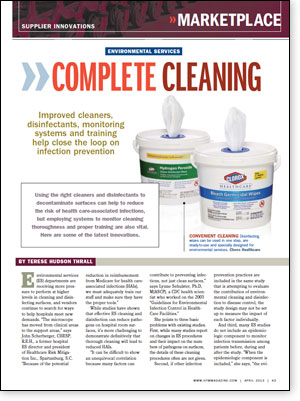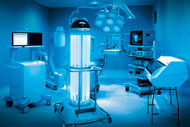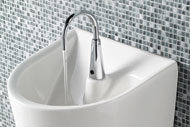 Using the right cleaners and disinfectants to decontaminate surfaces can help to reduce the risk of health care-associated infections, but employing systems to monitor cleaning thoroughness and proper training are also vital. Here are some of the latest innovations.
Using the right cleaners and disinfectants to decontaminate surfaces can help to reduce the risk of health care-associated infections, but employing systems to monitor cleaning thoroughness and proper training are also vital. Here are some of the latest innovations.
Environmental services (ES) departments are receiving more pressure to perform at higher levels in cleaning and disinfecting surfaces, and vendors continue to search for ways to help hospitals meet new demands. "The microscope has moved from clinical areas to the support areas," says John Scherberger, CHESP, R.E.H., a former hospital ES director and president of Healthcare Risk Mitigation Inc., Spartanburg, S.C. "Because of the potential reduction in reimbursement from Medicare for health care-associated infections (HAIs), we must adequately train our staff and make sure they have the proper tools."
While studies have shown that effective ES cleaning and disinfection can reduce pathogens on hospital room surfaces, it's more challenging to demonstrate definitively that thorough cleaning will lead to reduced HAIs.
"It can be difficult to show an unequivocal correlation because many factors can contribute to preventing infections, not just clean surfaces," says Lynne Sehulster, Ph.D, M(ASCP), a CDC health scientist who worked on the 2003 "Guidelines for Environmental Infection Control in Health-Care Facilities."
She points to three basic problems with existing studies. First, while many studies report on changes in ES procedures and their impact on the numbers of pathogens on surfaces, the details of these cleaning procedures often are not given.
Second, if other infection prevention practices are included in the same study that is attempting to evaluate the contribution of environmental cleaning and disinfection to disease control, the study design may not be set up to measure the impact of each factor individually.
And third, many ES studies do not include an epidemiologic component to monitor infection transmission among patients before, during and after the study. "When the epidemiologic component is included," she says, "the evidence is much more supportive of ES cleaning procedures' making a difference." But she adds that more well-designed studies are needed.
Scherberger says that even with a lack of national studies, he is confident there's a correlation between low occurrence of HAIs and effective ES cleaning practices. This belief stems from his own experience as an ES director. When his staff had checklists, complete processes and good tools for cleaning rooms, HAI rates fell.
Complete ES systems
Some vendors are responding to the increased pressure on ES departments by creating comprehensive systems, including cleaners, tools, and training and monitoring systems. Spartan Chemical Co., Maumee, Ohio, is one such firm. Late last year, Spartan Chemical announced the release of Spartan HealthCheck, a three-pronged approach to help ES departments perform at a high level. HealthCheck includes training, validation and documentation, using computer software. Most of the components of HealthCheck are free or can be received for a nominal cost as part of a package for Spartan Chemical customers. This arrangement highlights the idea that Spartan — and other firms offering an entire package — wants to be viewed as a partner, not a vendor.
As part of the package, Spartan Chemical offers multilingual Web-based training for ES associates, complete with certification testing. "The importance of training hasn't changed," says John Schauff, Spartan Chemical's director of government services. "But our understanding of its effectiveness has." Schauff notes that studies have shown that ES workers can fail to adhere to all procedures within 90 days without continuing education. "As a new employee, you get a lot of information at once," explains Schauff. "So it helps to have reminders." ES staff may have come from non-health-care work, or have developed short cuts in response to time pressures, he adds. Spartan Chemical recommends that health care facilities monitor cleaning performance to see when workers need a refresher.
Marking and monitoring
Through a partnership with Hygiena, Camarillo, Calif., Spartan Chemical is offering adenosine triphosphate (ATP) testing and monitoring with Hygiena's SystemSure Plus product, while it also offers its own UV check tools, using hermetically sealed, disposable UV marking swabs.
Schauff notes that some of the firm's customers use both types of verification systems, and believes more will start. For those health care facilities using both, the UV system, which is less expensive, can be used for training; the ATP system, which detects organic matter, provides a way to numerically monitor the effectiveness of a cleaning protocol.
Steve Nason, director of sales and marketing for Hygiena, says that a quarter to a third of all hospitals are using ATP now and he expects that percentage to rise. Schauff agrees, noting that as more and more hospitals become aware of an ATP system's current price point, they will see it as an attractive addition to their arsenal of ES products.
With growth in mind, Hygiena recently came out with instrumentation that can track 5,000 locations. "For large hospitals, our machine with 250 programmable locations was limiting," says Nason. In addition, the system's software has been improved so that tracking and trending data is easier. The new functionality will allow a health care system to link data from multiple hospitals over a Wide Area Network.
"Now they can see how each hospital in the network is doing with cleanliness and see the outliers," says Nason. "It may be [that] an underperforming hospital is not using the correct sanitizers or it has older cleaning equipment that isn't as effective, or a hospital's ES staff have high turnover. But most of the time it comes down to training."
The more progressive customers are the ones who choose to share data, he adds, because their organizational cultures encourage using data to improve performance instead of using it to spread blame. "The ATP system should not be viewed as tattletale equipment," says Nason, "It can validate what hospital staff are doing correctly, or motivate them to reach a higher level of cleaning."
Sharing and comparing information to drive continuous improvement is the whole point behind the data collection at Ecolab, Saint Paul, Minn. Last October, the firm collected data from 78 hospitals that use its EnCompass Environmental Hygiene Program and DAZO fluorescent gel marking system. The findings for patient rooms: The most cleaned high-touch areas were the toilet seat, the tray table and the room sink. The least cleaned were the bathroom light switch, room doorknob and the room light switch. "The least cleaned items are places that visitors and staff are likely to touch, so it's not just the patients that ES staff are protecting with clean patient rooms," says Linda Homan, R.N., CIC, senior manager of clinical and professionals services for Ecolab's health care business.
To be part of the Ecolab's first benchmark report, hospitals had to perform a baseline audit and 10 post-implementation audits. Homan expects more hospitals to have that data this year, enlarging the database. At the same time, she plans for Ecolab's data to move beyond patient rooms to the emergency department, the intensive care unit, the operating room and exam rooms, each with its own set of high-touch objects. "If we have enough data in those modules, we will include them in the benchmarking report this year," she says.
In the meantime, all Ecolab customers have their own data available 24/7. "The most important thing," says Homan, "is to see how the hospital is doing compared with itself over time. You want to be able to show continuous improvement."
As the number of hospitals using environmental monitoring systems increases, Homan and industry observers say it's possible that professional organizations, standard-setting and/or regulatory agencies may require data from hospitals that are tracking their cleaning performance.
"As programs like Encompass gain traction," she notes, "there's going to be more and more of a push for hospitals to show they are monitoring environmental cleaning."
Cleaning chemistry
The marketplace offers hospitals a variety of cleaning options, including ultraviolet light and hydrogen peroxide vapor systems, disinfecting wipes and quaternary ammonium compounds. The quat compounds can be diluted on-site at health care facilities or can be purchased in ready-to-use quat and alcohol combinations. Industry experts point out that each of these cleaners has its advantages and drawbacks.
For instance, vapor systems are effective, but can seem expensive to hospital administrators, and the vapor cleaning process can take a few hours. Quat compounds continue to be used widely at hospitals, according to Scherberger, because of their low cost. However, others point out that it requires staff time to mix the compounds and there's a chance for human error in achieving the correct concentration. In addition, the EPA-required contact time for disinfection may entail rewetting the surface several times. Ready-to-use disinfectant wipes work quickly, but generate waste.
Disinfectants are an important part of the infection prevention bundle, and offer ES staff ways to combat the most prevalent pathogens in health care, such as Norovirus and Clostridium difficile. According to the CDC's 2012 Vital Signs Report, C. diff infections are at an all-time high and reported in health care facilities beyond hospitals.
With a large portfolio of bleach-based products EPA-registered to kill C. diff spores, Clorox Healthcare offers Bleach Germicidal Wipes that kill 51 microorganisms, including C. diff, TB and Norovirus.
The wipes are available in three sizes designed for multipurpose use in such health care areas as operating suites, the emergency department and patient rooms.
"We understand the need to have the right products that are cost-effective, evidence-based, ready-to-use and support compliance to reduce infections," says Kim LaFreniere, Ph.D., associate research fellow, Clorox Healthcare.
Microfiber on the rise
Some 70 percent of hospitals are using microfiber mops and cloths, says Ying Zhang, senior manager for product marketing at Rubbermaid Commercial Products, Winchester, Va. She notes that the company has third-party claims that Rubbermaid's microfiber mops can remove 99.9 percent of microbes with water. The company recently made an addition to its Rubbermaid Pulse mopping system by adding a double-sided frame, which allows ES staff to dust mop with one side and wet mop with the other.
Rubbermaid is planning to release a disposable microfiber mop later this year, which Zhang says can be used in conjunction with launderable microfiber mops for enhanced infection control. "The disposables can be used in the isolation areas, while the reusable mops can be used in patient rooms and noncritical areas," she adds.
Scherberger says he expects more facilities to start using microdenier, a type of microfiber effective at removing surface bacteria and offered by companies such as umf Corp., Skokie, Ill. "The fibers are smaller than the microbes they are wiping up," he says, so the fabric works exceptionally well as a trap-and-remove cleaning tool.
Regardless of how health care facilities attack cleaning their environments, it is more likely to be a priority with management, ES vendors agree. With the average cost of a single HAI ranging between $10,000 and $40,000, the tie between cleanliness and reimbursement has become very real, says Clorox Healthcare's LaFreniere. "The importance of ES has definitely risen to the C-suite," she adds. HFM
Terese Hudson Thrall is a freelance health care writer based in the Chicago area and former associate editor for Health Facilities Management.
| Sidebar - For more information |
| For further details on the products featured in this month's "Marketplace" article, readers can contact the following vendors: »Spartan Chemical Co. »Hygiena »Ecolab »Clorox Healthcare »Rubbermaid Commercial Products »umf Corp. »PDI |




